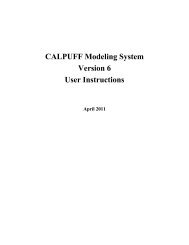Volume 1 - The Atmospheric Studies Group at TRC
Volume 1 - The Atmospheric Studies Group at TRC
Volume 1 - The Atmospheric Studies Group at TRC
You also want an ePaper? Increase the reach of your titles
YUMPU automatically turns print PDFs into web optimized ePapers that Google loves.
Winds in the UP.DAT file are given no influence in the boundary layer where the<br />
tracer transport and dispersion takes place.<br />
Over w<strong>at</strong>er, the boundary layer structure is characterized by the wind speed, air-sea<br />
temper<strong>at</strong>ure difference, rel<strong>at</strong>ive humidity and vertical temper<strong>at</strong>ure gradient listed in<br />
the SEA.DAT file. <strong>The</strong> overw<strong>at</strong>er mixing height is taken directly from the<br />
SEA.DAT file and tre<strong>at</strong>ed as an observ<strong>at</strong>ion. Over land, the boundary layer structure<br />
is characterized by the wind speed and cloud cover listed in the SURF.DAT file,<br />
along with the gridded surface characteristics contained in the geophysical d<strong>at</strong>a file<br />
th<strong>at</strong> account for land use vari<strong>at</strong>ions. <strong>The</strong> daytime mixing height over land includes<br />
the history of the computed surface fluxes and accounts for the modific<strong>at</strong>ion of the<br />
temper<strong>at</strong>ure structure aloft provided in the UP.DAT file. Note th<strong>at</strong> mixing heights<br />
are modified for advection affects which for on-shore flow typical of these d<strong>at</strong>asets<br />
produces a daytime thermal internal boundary layer (TIBL).<br />
Altern<strong>at</strong>e methods for computing the overw<strong>at</strong>er boundary layer parameters are<br />
selected <strong>at</strong> each site to explore the sensitivity of model performance to these choices.<br />
<strong>The</strong> new COARE algorithm option switch (ICOARE) has the following settings:<br />
0: OCD-like original flux model (default)<br />
10: COARE with no wave parameteriz<strong>at</strong>ion (Charnock parameter for the open<br />
ocean, or “deep w<strong>at</strong>er” – can be modified for “shallow w<strong>at</strong>er”)<br />
11: COARE with wave option 1 (Oost et al., 2002) and default equilibrium wave<br />
properties<br />
-11: COARE with wave option 1 (Oost et al., 2002) and observed wave<br />
properties (provided in revised SEA.DAT input file)<br />
12: COARE with wave option 2 (Taylor and Yelland, 2001) and default<br />
equilibrium wave properties<br />
-12: COARE with wave option 2 (Taylor and Yelland, 2001) and observed wave<br />
properties (provided in revised SEA.DAT input file)<br />
Because observed wave properties are not part of these d<strong>at</strong>asets, options -11 and -12<br />
are not tested. When ICOARE=10, an adjustment to the Charnock constant in the<br />
roughness length can be applied to differenti<strong>at</strong>e between open-ocean (“deep w<strong>at</strong>er”)<br />
loc<strong>at</strong>ions and near-shore (“shallow w<strong>at</strong>er”) loc<strong>at</strong>ions. We test this using both the<br />
original deep w<strong>at</strong>er and the proposed shallow w<strong>at</strong>er limits to determine if the original<br />
deep-w<strong>at</strong>er formul<strong>at</strong>ion may be used everywhere. <strong>The</strong> goal of this endeavor is to<br />
determine if any of these options is able to produce significantly better performance,<br />
thereby guiding the recommend<strong>at</strong>ion for configuring this aspect of the COARE<br />
module. Results for each of these options are labeled as 0, 10d, 10s, 11, 12, where<br />
Final Report Vol.1 56







